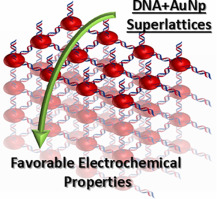Electrochemistry Communications ( IF 4.7 ) Pub Date : 2018-04-05 , DOI: 10.1016/j.elecom.2018.04.001 Sergio Kogikoski , Lauro T. Kubota

|
Electrochemical processes involving self-assembled nanoparticles are currently the subject of intense research. In most studies nanoparticles are drop-cast onto an insulating barrier; however, this method has a considerable drawback in that it does not offer control over the deposition process. In this work we use a strategy based on the self-assembly of programmable atom equivalents consisting of AuNPs with complementary DNA strands. We studied the properties of the resulting films by EIS and CV. The results showed that the 3D structure influences the electrical conduction. The results of the impedance studies showed that conduction depends on the organization and thickness of the superlattice film. Our results demonstrate the formation of a hybrid electroactive device with a well-organized structure composed of different nano-sized entities working together. Our results thus pave the way for the future development of electrochemically active nanomachines based on DNA nanostructures.
中文翻译:

自组装DNA-金纳米粒子晶格膜的电化学行为
涉及自组装纳米颗粒的电化学过程目前是广泛研究的主题。在大多数研究中,将纳米粒子滴铸到绝缘层上;然而,该方法具有很大的缺点,因为它不能提供对沉积过程的控制。在这项工作中,我们使用一种基于自组装原子等价物的自组装策略,该等价物由具有互补DNA链的AuNP组成。我们通过EIS和CV研究了所得薄膜的性能。结果表明,3D结构会影响电导率。阻抗研究的结果表明,导电取决于超晶格薄膜的组织和厚度。我们的结果证明了混合电活性器件的形成,该器件具有组织良好的结构,该结构由不同的纳米级实体共同工作。因此,我们的结果为基于DNA纳米结构的电化学活性纳米机器的未来发展铺平了道路。











































 京公网安备 11010802027423号
京公网安备 11010802027423号